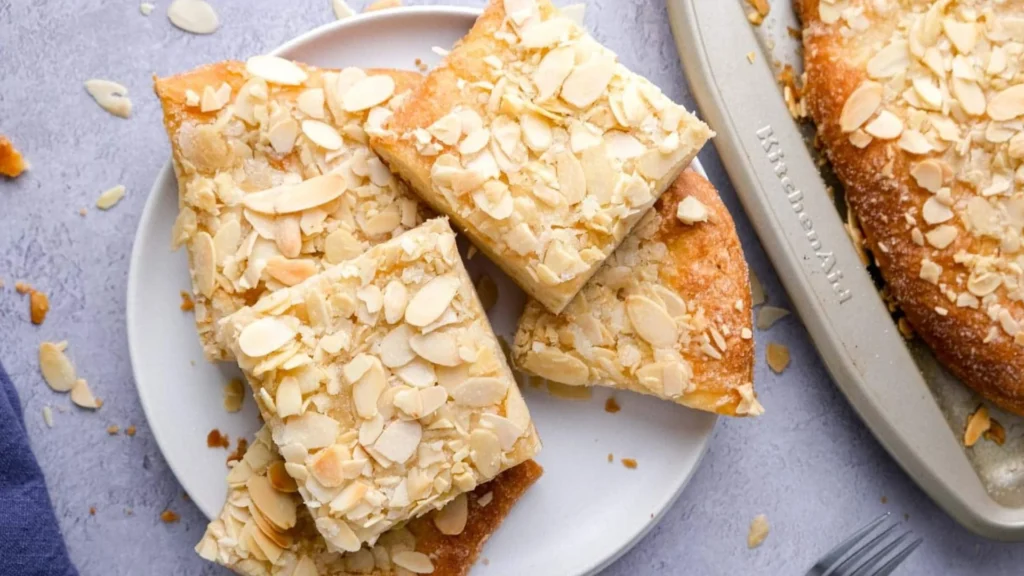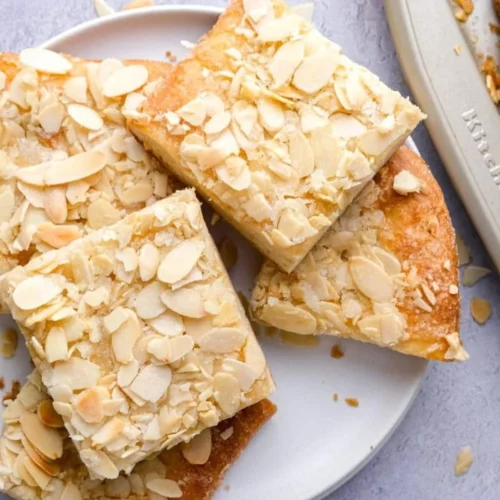German butter cake recipe is a traditional soft yeast cake topped with sugar, butter, and almonds. I’ve made this German butter cake recipe several times, each time refining it to match my taste.
My family enjoys this cake, especially when it’s fresh and still slightly warm. I first tried baking it in the classic bakery style, but over time I made small modifications like adjusting the butter amount and adding a hint of vanilla.
Now, I’ll show the complete step-by-step method I use for this German butter cake recipe, based on personal experience and how it’s become a favorite at home.
About This Recipe
German butter cake recipe, also known as Butterkuchen, is a classic yeast-based cake that’s soft, fluffy, and topped with rich butter, sugar, and sliced almonds.
Popular across Germany, it’s traditionally served with coffee and loved for its sweet, buttery flavor and slightly crisp topping.
The dough rises twice, creating a light texture, while the cold butter melts into the top during baking, forming irresistible golden pockets.
This German butter cake recipe is simple to make with everyday ingredients and brings a taste of traditional German baking to your kitchen. It’s perfect for gatherings, holidays, or any time you crave something warm and comforting.
How To Make German Butter Cake Recipe?
Let’s walk through the German Butter Cake recipe step-by-step to ensure great results. I’ve explained everything clearly and included useful tips to help along the way.
I’ll also mention the kitchen tools I find helpful though not all are necessary. Use whatever you have, and you’ll still bake a delicious, classic German butter cake recipe with ease.
Preparation Time: 20 minutes
Baking Time: 25 minutes
Total Time: About 45 minutes
Course: Dessert / Cake
Cuisine: German
Yield: 12 servings

Kitchen Utensils
- Mixing bowls
- Measuring cups and spoons
- Whisk
- Stand mixer with dough hook or wooden spoon and strong hands
- 9×13-inch (23x33cm) baking pan
- Clean kitchen towel
- Oven
Ingredients
For the Dough:
- 3 ¼ cups (400g) all-purpose flour
- 1 packet (2 ¼ tsp or 7g) active dry yeast
- ¾ cup (180ml) warm milk (about 110°F / 43°C)
- ¼ cup (50g) granulated sugar
- 1 large egg
- 1 tsp vanilla extract
- ½ tsp salt
- ⅓ cup (75g) unsalted butter, softened
For the Topping:
- ½ cup (100g) granulated sugar
- ½ cup (110g) cold unsalted butter, cut into small cubes
- ½ cup (50g) sliced almonds
Instructions
1. Activate the yeast:
Warm the milk to about 110°F (43°C)—it should feel warm, not hot. In a small bowl, combine the warm milk and yeast with a pinch of sugar. Stir gently and let it sit for 5–10 minutes until it becomes foamy. This means the yeast is active and ready.
2. Mix the dough:
In a large mixing bowl, add the flour, sugar, and salt. Stir together. Add the egg, vanilla extract, softened butter, and the activated yeast mixture. Mix everything together using a stand mixer fitted with a dough hook, or knead by hand for about 8–10 minutes, until the dough is smooth and elastic.
3. Let the dough rise:
Form the dough into a ball and place it in a lightly oiled bowl. Cover it with a clean kitchen towel and let it rise in a warm place for about 1 hour, or until doubled in size.
4. Prepare the pan:
Grease a 9×13-inch (23×33 cm) baking pan or line it with parchment paper. After the dough has risen, gently press it into the bottom of the prepared pan, spreading it out evenly with your hands.
5. Add the topping:
Using your fingers or the back of a spoon, press little dimples all over the surface of the dough. Evenly sprinkle the granulated sugar over the dough, then distribute the small cubes of cold butter across the top, letting some fall into the dimples. Finally, scatter the sliced almonds over everything.
6. Final rest:
Let the assembled cake rest for 15–20 minutes while the oven preheats to 350°F (180°C).
7. Bake the cake:
Place the cake in the preheated oven and bake for 20–25 minutes, or until the top is golden brown and the edges are just starting to pull away from the pan. Remove from the oven and let cool slightly before slicing.
Notes:
German butter cake recipe is best enjoyed fresh the day it’s baked. For a variation, add a few drops of almond extract to the dough for extra flavor. You can dust the cooled cake lightly with powdered sugar before serving for a sweeter touch.
Nutrition Facts Of German Butter Cake Recipe
| Nutrition | Amounts |
|---|---|
| Calories | 290 |
| Fat | 15g |
| Saturated Fat | 9g |
| Carbohydrates | 35g |
| Sugar | 12g |
| Protein | 5g |
| Fiber | 1g |
| Sodium | 120mg |
Why This Recipe Is A Must-Try?
This German butter cake recipe is a must-try because it combines simple ingredients to create a rich, comforting cake that feels homemade yet special.
The contrast between the soft yeast dough and the crunchy, buttery almond topping makes each bite enjoyable. It’s easy to follow, even for those new to yeast baking, and yields consistent results.
The German butter cake recipe subtle sweetness and buttery flavor appeal to a wide range of tastes, making it a hit with family and friends.
Trying this recipe brings a slice of traditional German baking into your kitchen, offering a satisfying experience that’s both nostalgic and delicious.
Health Benefits
German butter cake recipe is a treat that offers some basic nutritional benefits, mainly from its ingredients. The almonds in the topping provide healthy fats, vitamin E, and some protein, which contribute to heart health and provide antioxidants.
The yeast dough contains carbohydrates, which supply energy. Butter adds richness and fat-soluble vitamins like A and D, though it should be enjoyed in moderation.
While this German butter cake recipe is not a health food, enjoying it in reasonable portions can be part of a balanced diet, especially when paired with nutrient-rich foods like fresh fruit or a cup of tea.
Expert Tips
1. Always check the expiration date on your yeast and proof it in warm milk with a little sugar. If it doesn’t foam after 5–10 minutes, the yeast is inactive and won’t help the dough rise properly.
2.The milk temperature is crucial. If it’s too hot, it will kill the yeast and prevent rising; if too cold, the yeast won’t activate. Aim for around 110°F (43°C) for the perfect environment.
3. Give the dough plenty of time to rise in a warm, draft-free area. This slow fermentation develops flavor and creates a soft, airy texture. Rushing this step will result in a dense cake.
4. When spreading the dough in the pan, press your fingers all over to create dimples. These indentations hold the butter and sugar during baking, allowing the topping to caramelize beautifully and evenly.
5. Using cold butter for the topping is key. As it melts in the oven, it creates little pockets of rich flavor and helps the sugar caramelize without melting away completely, forming that signature crunchy crust.
6. After assembling the cake with its topping, let it rest briefly before baking. This final proofing helps the dough relax and absorb the flavors from the butter and sugar, resulting in a moist, flavorful cake with a perfect crumb.
Why My Recipe Works
My German butter cake recipe works because it balances a tender yeast dough with a rich, buttery topping that melts into the surface during baking.
The yeast dough rises properly, creating a soft and airy base that isn’t too dense or dry. The small cubes of cold butter in the topping slowly melt, mixing with the sugar and almonds to form a delicious caramelized crust.
Allowing the dough to rise fully and pressing dimples into the dough helps the butter and sugar settle perfectly. These key steps ensure a moist, flavorful cake that keeps well and satisfies everyone who tries it.
My Favorite Ways To Serve It Up
I enjoy serving German butter cake recipe at room temperature, allowing the flavors to settle and the texture to become tender. It pairs nicely with a glass of cold milk or a warm herbal tea, which helps cut through the richness.
Occasionally, I add a light dusting of powdered sugar on top for a subtle sweetness boost. For a more indulgent treat, serving it alongside vanilla yogurt or fresh fruit like sliced strawberries adds a refreshing element.
When sharing with guests, I slice it into neat rectangles for easy handling, making German butter cake recipe perfect for casual coffee breaks or afternoon snacks.
What Is The Best Way To Reheat Leftover German Butter Cake?
To enjoy leftover cake warm and soft, heat individual slices in a low oven (around 150°C or 300°F) for 5–10 minutes. This revives the buttery topping and softens the dough.
Alternatively, microwaving for about 15 seconds works well if you’re short on time, but be careful not to overheat to avoid drying out the cake. Warming enhances the flavors and texture, making leftovers just as enjoyable.
How Long Will German Butter Cake Stay Fresh Once Baked?
When stored properly in an airtight container at room temperature, German butter cake remains fresh and soft for about two days.
If you want to keep it longer, refrigeration can extend its freshness for up to a week. Before serving, allow it to come back to room temperature or warm it slightly to regain its tender texture.
Can I Substitute Instant Yeast For Active Dry Yeast In This Recipe?
Yes, instant yeast can be used as a substitute. Since instant yeast is more concentrated, reduce the amount slightly (about 25% less) and mix it directly into the dry ingredients without proofing in warm milk first. This can save time and still give a good rise.
Is It Essential To Use Sliced Almonds For The Topping?
Sliced almonds add a classic crunch and nutty flavor to the topping, but they are not mandatory. You can replace them with other nuts like chopped hazelnuts or walnuts, or skip nuts entirely if preferred. The cake will still taste delicious with just the butter and sugar topping.
Is It Possible To Make This Recipe Gluten-Free?
Traditional German butter cake relies on all-purpose wheat flour for structure and texture. However, you can experiment with a high-quality gluten-free flour blend designed for baking. Keep in mind that some adjustments in liquid or rising times might be needed for best results.
How Can I Tell When The Cake Is Fully Baked?
The cake is done when the top turns a deep golden brown and the edges start to pull away slightly from the pan. To be sure, insert a toothpick or cake tester into the center if it comes out clean or with only a few moist crumbs, the cake is ready. Avoid overbaking to keep it moist and tender.
How To Store Leftovers
Store leftover German butter cake recipe in an airtight container at room temperature for up to two days to keep it soft and fresh. If you want it to last longer, wrap the cake tightly in plastic wrap or foil and refrigerate for up to five days.
Before serving refrigerated cake, let it come to room temperature or warm it slightly in the oven for a few minutes to restore its buttery texture.
For longer storage, you can freeze individual slices wrapped well in plastic wrap and placed in a freezer bag for up to three months. Thaw overnight in the fridge before enjoying.
Conclusion
This German butter cake recipe is one of my all-time favorites that I’ve baked and enjoyed many times. The soft, tender dough paired with the rich, buttery, crunchy topping is always irresistible and keeps me coming back for more.
I bake German butter cake recipe repeatedly because it never fails to satisfy. I’ve written the instructions clearly so you can easily follow along and enjoy making it yourself.
Once you try this German butter cake recipe, you’ll see why it holds a special place in my kitchen and why it’s worth making again and again.
More Butter Cake Recipes You’ll Love
Erin French Butter Cake Recipe | Moist And Buttery
Butter Cake Mastro’s Recipe (Copycat)
Almond Butter Cake Recipe | Easy And Healthy
Spiced Apple Butter Cake Recipes
Best Peanut Butter Chocolate Cake Cheesecake

German Butter Cake Recipe
Equipment
- Mixing bowls
- Measuring cups and spoons
- Whisk
- Stand mixer with dough hook or wooden spoon and strong hands
- 9×13-inch (23x33cm) baking pan
- Clean kitchen towel
- Oven
Ingredients
For the Dough:
- 3 ¼ cups 400g all-purpose flour
- 1 packet 2 ¼ tsp or 7g active dry yeast
- ¾ cup 180ml warm milk (about 110°F / 43°C)
- ¼ cup 50g granulated sugar
- 1 large egg
- 1 tsp vanilla extract
- ½ tsp salt
- ⅓ cup 75g unsalted butter, softened
For the Topping:
- ½ cup 100g granulated sugar
- ½ cup 110g cold unsalted butter, cut into small cubes
- ½ cup 50g sliced almonds
Instructions
Activate the yeast:
- Warm the milk to about 110°F (43°C)—it should feel warm, not hot. In a small bowl, combine the warm milk and yeast with a pinch of sugar. Stir gently and let it sit for 5–10 minutes until it becomes foamy. This means the yeast is active and ready.
Mix the dough:
- In a large mixing bowl, add the flour, sugar, and salt. Stir together. Add the egg, vanilla extract, softened butter, and the activated yeast mixture. Mix everything together using a stand mixer fitted with a dough hook, or knead by hand for about 8–10 minutes, until the dough is smooth and elastic.
Let the dough rise:
- Form the dough into a ball and place it in a lightly oiled bowl. Cover it with a clean kitchen towel and let it rise in a warm place for about 1 hour, or until doubled in size.
Prepare the pan:
- Grease a 9×13-inch (23×33 cm) baking pan or line it with parchment paper. After the dough has risen, gently press it into the bottom of the prepared pan, spreading it out evenly with your hands.
Add the topping:
- Using your fingers or the back of a spoon, press little dimples all over the surface of the dough. Evenly sprinkle the granulated sugar over the dough, then distribute the small cubes of cold butter across the top, letting some fall into the dimples. Finally, scatter the sliced almonds over everything.
Final rest:
- Let the assembled cake rest for 15–20 minutes while the oven preheats to 350°F (180°C).
Bake the cake:
- Place the cake in the preheated oven and bake for 20–25 minutes, or until the top is golden brown and the edges are just starting to pull away from the pan. Remove from the oven and let cool slightly before slicing.
Notes
| Nutrition | Amounts |
|---|---|
| Calories | 290 |
| Fat | 15g |
| Saturated Fat | 9g |
| Carbohydrates | 35g |
| Sugar | 12g |
| Protein | 5g |
| Fiber | 1g |
| Sodium | 120mg |

Hi! I’m Sophia, your trusted cake guide with years of hands-on baking experience. I’m passionate about creating delicious and wholesome cakes that bring happiness to every occasion and home. Whether you’re a beginner or seasoned baker, I’m here to share tips, recipes, and inspiration to make your baking journey enjoyable and rewarding. From classic flavors to healthy twists, my goal is to help you discover the joy of baking and sharing beautiful cakes with family and friends.